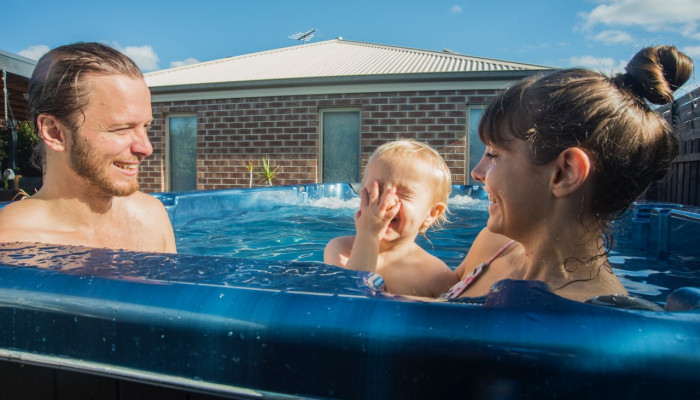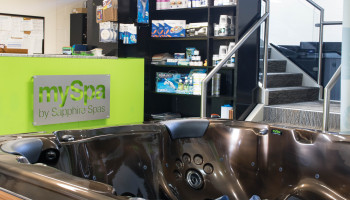
If you own a spa pool or hot tub in Sydney, at some point you’ll find yourself facing high chlorine levels. Most of the time it's not even intentional — it just happens!
If you've recently found yourself in that situation, don't worry: we've got you sorted. In this article, we’ll talk about how you can lower or counteract chlorine in your hot tub or spa pool easily.
Here’s what this article cover,
- What causes high chlorine levels?
- How do I know what my spa pool chlorine levels are?
- How much chlorine should be in a spa pool?
- What happens if my spa pool has too much chlorine in it?
- How to reduce chlorine levels in a pool
- Frequently Asked Questions about spa pool chlorine
What causes high chlorine levels?
High chlorine levels are usually caused by adding too much chlorine into your hot tub or spa pool by mistake. You may have added more chlorine than you intended, or you may not have realised another user had already put chlorine in the pool before you.
Sometimes chlorine levels may go too high after shocking the spa water (that is, adding a high dose of chlorine to reactive sanitisers and kill bacteria). Overdoing the chlorine can happen to anyone
Read more: How to Keep Your Spa Pool Water Cleaner for Longer
How do I know what my spa pool chlorine levels are?
To check how much chlorine should be in your spa pool, make sure to test your pool water with either test strips or a liquid test kit. This will give you the most accurate result.
If you are testing your spa pool several times a week, keep track of what your levels are and adjust accordingly if necessary.
How much chlorine should be in a spa pool?
An ideal chlorine level is 3 ppm. Chlorine levels below 2 ppm may mean your spa pool is not properly sanitised. Meanwhile, chlorine levels above 4 ppm are too high and may be harsh on your skin. Anything above 6 ppm is unsafe, and should not be swum in.
What happens if my spa pool has too much chlorine in it?
If your spa pool has too much chlorine, you’ll notice your swimwear’s colour fading after one use or chemical damage to your pool cover.
Having too much chlorine in the spa pool can be dangerous if you have friends and family members who have sensitive skin or underlying health conditions.
For example, it may cause eye irritation, over-dried skin, and possibly some breathing problems.
Excess chlorine will vaporise and form a gas that floats just above the water's surface. If this vapour is inhaled it can inflame airways and exacerbate certain breathing conditions.
Read more: What Temperature Should My Spa Pool be at and Why?
How to lower chlorine levels in a hot tub or spa pool:
1.Leave it to evaporate
To counteract chlorine and reduce the levels in the pool you can leave the cover off of the pool for a few days. Ultraviolet light from the sun will break down chlorine naturally over time.
Make sure no one goes into the spa pool until the levels have dropped back down into the safe range.
While you're waiting for nature to work its magic, don't add any chlorine to the water either.
2. Drain and refill the pool
If you need to reduce your chlorine levels by 1-2 ppm, diluting your pool water by draining and adding fresh water is another option.
This also means other chemicals in your spa pool are being drained too, so make sure to test the water after.
The addition of freshwater will change your pH, alkalinity, and calcium hardness levels. Remember to adjust these once you've finished adding fresh water to the pool.
3. Use the spa pool
If you're trying to reduce chlorine levels by 1-3 ppm then another option to neutralise chlorine is to use the spa pool. Get your friends and family together to hop in for a swim.
Levels of around 5 ppm can be high but are generally safe for swimming. Make sure not to swim in water with chlorine levels above 6 ppm.
If you do, you and other people in the spa pool could run the risk of serious skin irritation and discomfort.
4. Use oxidising chemicals
To counteract chlorine in your spa pool sometimes you may need to use chemicals to help you out.
Hydrogen peroxide is sold as a pool chemical oxidizer, which means it works to break down chlorine through chemical reactions.
You'll need to get hydrogen peroxide that's specifically made for pools, not the one sold in first aid kits.
If your pool's pH is higher than 7, hydrogen peroxide will react to reduce chlorine levels. If your level is below 7 it wont be effective, so you'll need to raise the pH before adding it.
5. Add a chlorine neutraliser
To neutralise chlorine in the spa pool, a chlorine neutralizer is also helpful. Sodium thiosulfate, sodium sulfite, sodium bisulfite, and sodium metabisulfite are all chemicals that can be sold as chlorine neutralisers.
These chemicals are a quick and easy way to reduce chlorine levels in a pool. Follow the chemical’s specific instructions to get the best results.
These types of chemicals can impact the pH of the water, so make sure you test the pH before and after adding the chemicals and adjust accordingly every time.
6. Add vitamin C
Adding vitamin C to the spa pool can also counteract chlorine. This works for very high chlorine levels that need to be lowered quickly.
It can also be used on vinyl liners and fibreglass surfaces.
Read More: What Not To Do When Using Your Hot Tub
Frequently Asked Questions about Spa Pool Chlorine
We’ve answered a few specific questions below, but be sure to check out our Frequently Asked Questions page if you’re left wondering!
What neutralises chlorine in a hot tub?
The best chemicals to neutralise chlorine in a hot tub are those marketing as chlorine neutralisers. You can get these chemicals from most shops that stock chlorine, such as pool supply shops like mySpa Sydney.
When buying chlorine neutraliser, look for one that has sodium thiosulfate, sodium sulfite, sodium bisulfite, or sodium metabisulfite, as these will be the best for quickly lowering chlorine levels.
Can I go in my hot tub if the chlorine is too high?
Maybe — it depends on how high the chlorine level is. Chlorine levels between 1-5 ppm are generally acceptable, although 3 ppm is ideal. If your chlorine levels are above 6 ppm, you’ll most likely bleach your swimwear or experience serious skin irritation.
Read more: How long should a spa pump run each day?
What is an unsafe level of chlorine in a hot tub?
We don’t recommend using a spa pool with chlorine levels over 5 ppm. Higher levels may result in damaged swimwear and a spa pool cover or skin irritation. If your chlorine levels are over 10 ppm, do not under any circumstances use your spa until the chlorine has been neutralised.
How long does it take for chlorine levels to drop in a spa pool?
It depends on how you’re lowering the levels. If you’re using a chlorine neutraliser, the reaction can happen very quickly and your spa should be safe to use again within a few minutes. If you’re letting the chlorine levels lower through evaporation, it can take overnight to a few days if the levels were very high.
Can too much chlorine make a hot tub cloudy?
Yes, cloudy water can be a sign of excess chlorine. Usually, cloudy water is a sign of an imbalance in your spa chemicals. Chlorine may be the issue, or it may be a problem with pH, alkalinity, calcium hardness or a sign your water should be drained and replaced.
Read more: How to change spa filters
What is the difference between chlorine and shock?
Chlorine is a sanitiser that should always be present in your spa water if you’re using the spa. It helps to fight bacteria and other contaminants, keeping your water hygienic.
Shock is a high dose of chlorine that is intended to raise water’s chlorine level very quickly. You might use shock if you need to kill bacteria in a pool, for example if it’s been used a few times without any extra chlorine added.
Got more questions about spa pool chemicals? Let us help!
If you have too much chlorine in your pool, counteracting it is simple. At one point or another, we've all needed to do it.
At mySpa Sydney we’re here for all your spa pool needs. Get in touch with us if you have any questions or are looking to buy a new spa pool.
You can contact us on 02 8850 6550 or fill out a contact form online.




